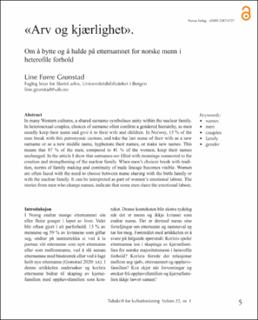| dc.contributor.author | Grønstad, Line Førre | |
| dc.date.accessioned | 2023-09-14T07:21:38Z | |
| dc.date.available | 2023-09-14T07:21:38Z | |
| dc.date.created | 2023-07-18T12:31:24Z | |
| dc.date.issued | 2023 | |
| dc.identifier.issn | 1502-7473 | |
| dc.identifier.uri | https://hdl.handle.net/11250/3089327 | |
| dc.description.abstract | In many Western cultures, a shared surname symbolises unity within the nuclear family. In heterosexual couples, choices of surname often confirm a gendered hierarchy, as men usually keep their name and give it to their wife and children. In Norway, 13 % of the men break with this patronymic custom, and take the last name of their wife as a new surname or as a new middle name, hyphenate their names, or make new names. This means that 87 % of the men, compared to 41 % of the women, keep their names unchanged. In the article I show that surnames are filled with meanings connected to the creation and strengthening of the nuclear family. When men’s choices break with tradition, norms of family making and continuity of male lineage becomes visible. Women are often faced with the need to choose between name sharing with the birth family or with the nuclear family. It can be interpreted as part of women’s emotional labour. The stories from men who change names, indicate that some men share the emotional labour. | en_US |
| dc.language.iso | nno | en_US |
| dc.publisher | Novus | en_US |
| dc.relation.uri | https://ojs.novus.no/index.php/TFK/article/view/2195/2161 | |
| dc.rights | Navngivelse-DelPåSammeVilkår 4.0 Internasjonal | * |
| dc.rights.uri | http://creativecommons.org/licenses/by-sa/4.0/deed.no | * |
| dc.title | «Arv og kjærlighet». Om å bytte og å halde på etternamnet for norske menn i heterofile forhold | en_US |
| dc.type | Journal article | en_US |
| dc.type | Peer reviewed | en_US |
| dc.description.version | publishedVersion | en_US |
| dc.rights.holder | Copyright 2023 the author | en_US |
| cristin.ispublished | true | |
| cristin.fulltext | original | |
| cristin.qualitycode | 1 | |
| dc.identifier.cristin | 2162698 | |
| dc.source.journal | Tidsskrift for kulturforskning | en_US |
| dc.source.pagenumber | 5-21 | en_US |
| dc.identifier.citation | Tidsskrift for kulturforskning. 2023, 22 (1), 5-21. | en_US |
| dc.source.volume | 22 | en_US |
| dc.source.issue | 1 | en_US |

